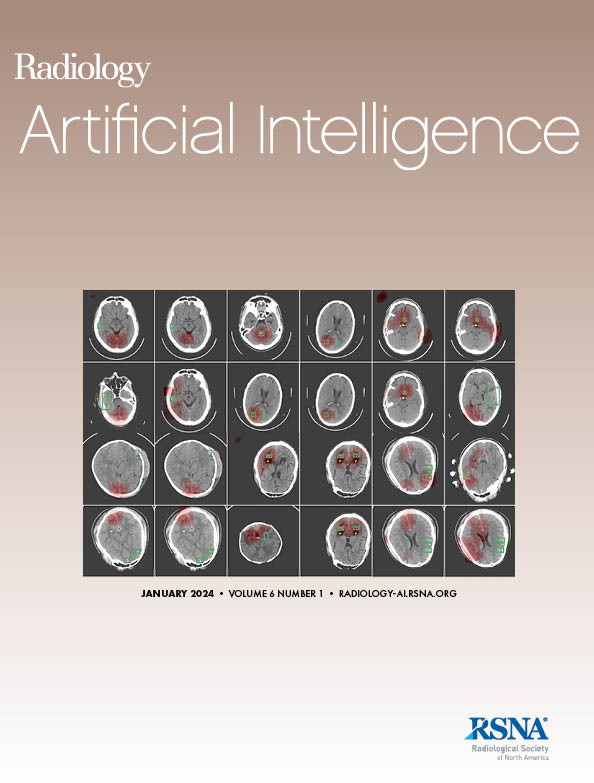Unsupervised Deep Learning for Blood-Brain Barrier Leakage Detection in Diffuse Glioma Using Dynamic Contrast-enhanced MRI.
IF 13.2
Q1 COMPUTER SCIENCE, ARTIFICIAL INTELLIGENCE
Joon Jang, Kyu Sung Choi, Junhyeok Lee, Hyochul Lee, Inpyeong Hwang, Jung Hyun Park, Jin Wook Chung, Seung Hong Choi, Hyeonjin Kim
求助PDF
{"title":"Unsupervised Deep Learning for Blood-Brain Barrier Leakage Detection in Diffuse Glioma Using Dynamic Contrast-enhanced MRI.","authors":"Joon Jang, Kyu Sung Choi, Junhyeok Lee, Hyochul Lee, Inpyeong Hwang, Jung Hyun Park, Jin Wook Chung, Seung Hong Choi, Hyeonjin Kim","doi":"10.1148/ryai.240507","DOIUrl":null,"url":null,"abstract":"<p><p>Purpose To develop an unsupervised deep learning framework for generalizable blood-brain barrier leakage detection using dynamic contrast-enhanced MRI, without requiring pharmacokinetic models and arterial input function estimation. Materials and Methods This retrospective study included data from patients who underwent dynamic contrast-enhanced MRI between April 2010 and December 2020. An autoencoder-based anomaly detection approach identified one-dimensional voxel-wise time-series abnormal signals through reconstruction residuals, separating them into residual leakage signals (RLSs) and residual vascular signals. The RLS maps were evaluated and compared with the volume transfer constant (<i>K</i><sup>trans</sup>) using the structural similarity index and correlation coefficient. Generalizability was tested on subsampled data, and isocitrate dehydrogenase (<i>IDH</i>) status classification performance was assessed using area under the receiver operating characteristic curve (AUC). Results A total of 274 patients (mean age, 54.4 years ± 14.6 [SD]; 164 male) were included in the study. RLS showed high structural similarity (structural similarity index, 0.91 ± 0.02) and correlation (<i>r</i> = 0.56; <i>P</i> < .001) with <i>K</i><sup>trans</sup>. On subsampled data, RLS maps showed better correlation with RLS values from the original data (0.89 vs 0.72; <i>P</i> < .001), higher peak signal-to-noise ratio (33.09 dB vs 28.94 dB; <i>P</i> < .001), and higher structural similarity index (0.92 vs 0.87; <i>P</i> < .001) compared with <i>K</i><sup>trans</sup> maps. RLS maps also outperformed <i>K</i><sup>trans</sup> maps in predicting <i>IDH</i> mutation status (AUC, 0.87 [95% CI: 0.83, 0.91] vs 0.81 [95% CI: 0.76, 0.85]; <i>P</i> = .02). Conclusion The unsupervised framework effectively detected blood-brain barrier leakage without pharmacokinetic models and arterial input function. <b>Keywords:</b> Dynamic Contrast-enhanced MRI, Unsupervised Learning, Feature Detection, Blood-Brain Barrier Leakage Detection <i>Supplemental material is available for this article.</i> © RSNA, 2025 See also commentary by Júdice de Mattos Farina and Kuriki in this issue.</p>","PeriodicalId":29787,"journal":{"name":"Radiology-Artificial Intelligence","volume":" ","pages":"e240507"},"PeriodicalIF":13.2000,"publicationDate":"2025-05-01","publicationTypes":"Journal Article","fieldsOfStudy":null,"isOpenAccess":false,"openAccessPdf":"","citationCount":"0","resultStr":null,"platform":"Semanticscholar","paperid":null,"PeriodicalName":"Radiology-Artificial Intelligence","FirstCategoryId":"1085","ListUrlMain":"https://doi.org/10.1148/ryai.240507","RegionNum":0,"RegionCategory":null,"ArticlePicture":[],"TitleCN":null,"AbstractTextCN":null,"PMCID":null,"EPubDate":"","PubModel":"","JCR":"Q1","JCRName":"COMPUTER SCIENCE, ARTIFICIAL INTELLIGENCE","Score":null,"Total":0}
引用次数: 0
引用
批量引用
Abstract
Purpose To develop an unsupervised deep learning framework for generalizable blood-brain barrier leakage detection using dynamic contrast-enhanced MRI, without requiring pharmacokinetic models and arterial input function estimation. Materials and Methods This retrospective study included data from patients who underwent dynamic contrast-enhanced MRI between April 2010 and December 2020. An autoencoder-based anomaly detection approach identified one-dimensional voxel-wise time-series abnormal signals through reconstruction residuals, separating them into residual leakage signals (RLSs) and residual vascular signals. The RLS maps were evaluated and compared with the volume transfer constant (K trans ) using the structural similarity index and correlation coefficient. Generalizability was tested on subsampled data, and isocitrate dehydrogenase (IDH ) status classification performance was assessed using area under the receiver operating characteristic curve (AUC). Results A total of 274 patients (mean age, 54.4 years ± 14.6 [SD]; 164 male) were included in the study. RLS showed high structural similarity (structural similarity index, 0.91 ± 0.02) and correlation (r = 0.56; P < .001) with K trans . On subsampled data, RLS maps showed better correlation with RLS values from the original data (0.89 vs 0.72; P < .001), higher peak signal-to-noise ratio (33.09 dB vs 28.94 dB; P < .001), and higher structural similarity index (0.92 vs 0.87; P < .001) compared with K trans maps. RLS maps also outperformed K trans maps in predicting IDH mutation status (AUC, 0.87 [95% CI: 0.83, 0.91] vs 0.81 [95% CI: 0.76, 0.85]; P = .02). Conclusion The unsupervised framework effectively detected blood-brain barrier leakage without pharmacokinetic models and arterial input function. Keywords: Dynamic Contrast-enhanced MRI, Unsupervised Learning, Feature Detection, Blood-Brain Barrier Leakage Detection Supplemental material is available for this article. © RSNA, 2025 See also commentary by Júdice de Mattos Farina and Kuriki in this issue.
无监督深度学习在弥漫性胶质瘤血脑屏障渗漏检测中的应用。
“刚刚接受”的论文经过了全面的同行评审,并已被接受发表在《放射学:人工智能》杂志上。这篇文章将经过编辑,布局和校样审查,然后在其最终版本出版。请注意,在最终编辑文章的制作过程中,可能会发现可能影响内容的错误。目的开发一种无监督深度学习框架,用于使用动态对比增强(DCE) MRI进行泛化血脑屏障(BBB)泄漏检测,而不需要药代动力学(PK)模型和动脉输入函数(AIF)估计。材料和方法本回顾性研究包括2010年4月至2020年12月期间接受DCE MRI检查的患者的数据。基于自编码器的异常检测(AEAD)通过重建残差识别一维体素时间序列异常信号,并将其分为残余泄漏信号(RLS)和残余血管信号(RVS)。利用结构相似指数(SSIM)和相关系数(r)对RLS图谱进行评价,并与体积传递常数(Ktrans)进行比较。对次采样数据进行了通用性测试,并利用受试者工作特征曲线(aus)下的面积评估了IDH状态分类性能。结果共纳入274例患者,其中男性164例;平均年龄54.23±[SD] 14.66岁)。RLS与Ktrans具有较高的结构相似性(SSIM = 0.91±0.02)和相关性(r = 0.56, P < 0.001)。在次采样数据上,与Ktrans图相比,RLS图与原始数据的RLS值具有更好的相关性(0.89比0.72,P < 0.001),更高的PSNR (33.09 dB比28.94 dB, P < 0.001)和更高的SSIM(0.92比0.87,P < 0.001)。RLS图谱在预测IDH突变状态方面也优于Ktrans图谱(AUC = 0.87 [95% CI: 0.83-0.91] vs . 0.81 [95% CI: 0.76-0.85], P = 0.02)。结论无监督框架在没有PK模型和AIF的情况下能有效检测血脑屏障渗漏。©RSNA, 2025年。
本文章由计算机程序翻译,如有差异,请以英文原文为准。
来源期刊
期刊介绍:
Radiology: Artificial Intelligence is a bi-monthly publication that focuses on the emerging applications of machine learning and artificial intelligence in the field of imaging across various disciplines. This journal is available online and accepts multiple manuscript types, including Original Research, Technical Developments, Data Resources, Review articles, Editorials, Letters to the Editor and Replies, Special Reports, and AI in Brief.

 求助内容:
求助内容: 应助结果提醒方式:
应助结果提醒方式:


